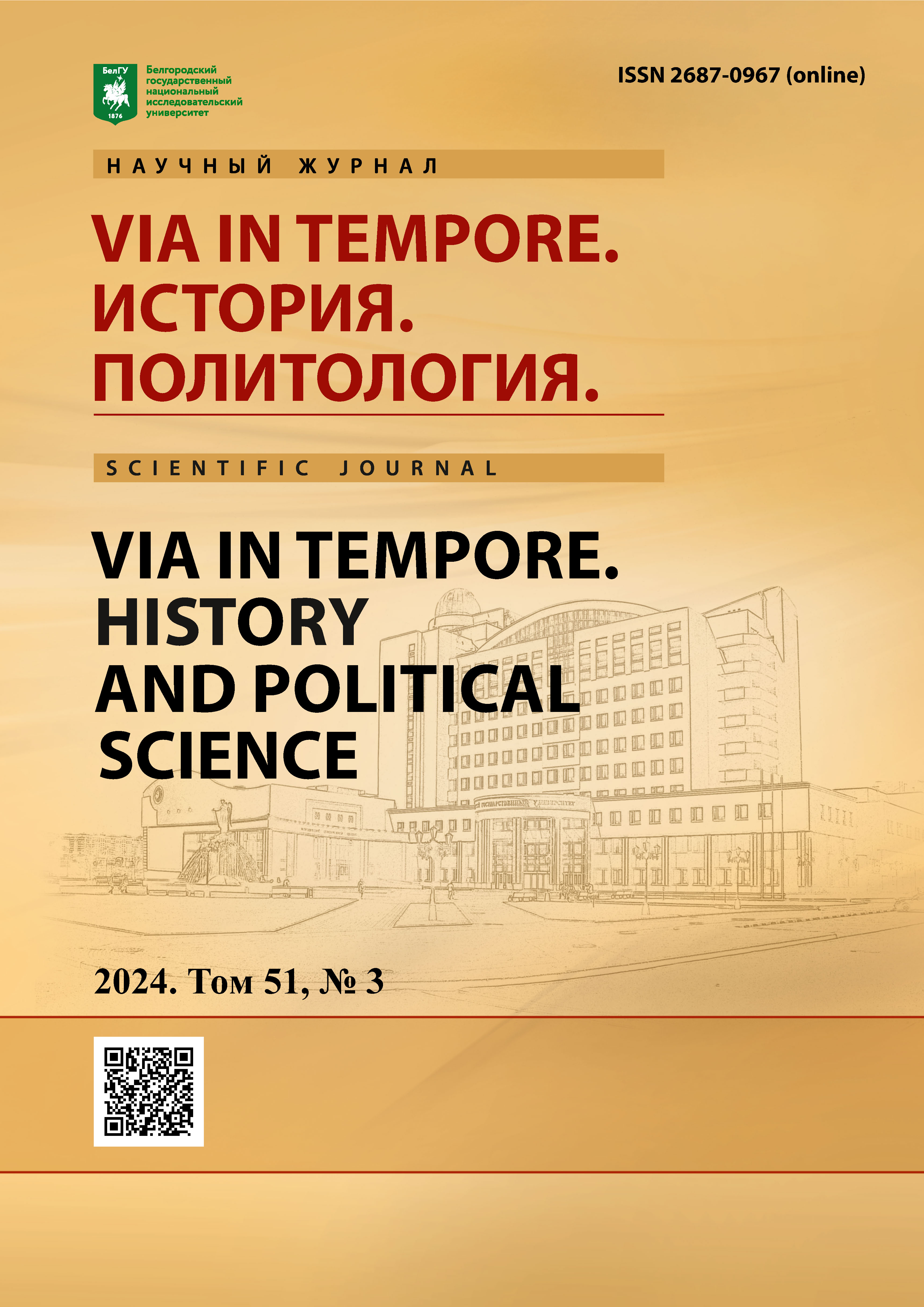Cappadocian Intellectuals of Early Byzantine Times in Their Homeland and in the Empire
DOI:
https://doi.org/10.52575/2687-0967-2024-51-3-539-549Keywords:
Cappadocia, intellectuals, Early Byzantium, ChristianityAbstract
The work attempts to give an outline of the state of intellectual life in early Byzantine Cappadocia through the prosopography of its main representatives. It is concluded that one of the most “non-antique” regions of the empire with very specific natural and geographical conditions produced quite a lot of bright intellectuals, mainly rhetoricians and Christian theologians. The latter also manifested themselves to a significant extent at the general imperial level – both as intellectuals (Julian of Cappadocia), theologians (Basil the Great, Gregory of Nazianzus), and as statesmen and courtiers (John of Cappadocia). The question of the attitude of the Cappadocian church fathers to the classical heritage is raised. One of the reasons for this kind of positive attitude can be considered the rhetorical education received by Basil and Gregory in Athens. We also stress the importance of the numerous presence of Cappadocians in the higher schools of the empire, primarily in Athens, which can be associated with the desire to overcome the difficulties created by the remote position of the region and the not entirely ancient nature of its culture and the inhabitants’ lifestyle.
Downloads
References
Алиева О.В. 1917. Послание к юношам об образовании в Каппадокии IV в. В: Аристей. Aristeas: Вестник классической филологии и античной истории. Т. 15: 77–89.
Бибиков М.В., Попов И.Н. 2012. Каппадокия. В: Православная энциклопедия. Т. 30. Москва, Православная энциклопедия, 568–601.
Болгов Н.Н., Денисова И.В. 2023. Ранневизантийские интеллектуалы, кто они? В: XV Международный Византийский семинар «ΧΕΡΣΩΝΟΣ ΘΕΜΑΤΑ: Империя и полис». Материалы научной конференции. Симферополь, Ариал: 89–99.
Болгова А.М. 2018. Ранневизантийские портреты: риторы, софисты, философы. Белгород, БелГУ, 404.
Болгова А.М. 2021. Школы и интеллектуалы в ранневизантийской Лидии. В: Классическая и византийская традиция. 2021. Белгород: 219–225.
Болгова А.М. 2022. Кария как центр высшего образования в Ранней Византии. В: Византийский «круг земель» Orbis terrarium Byzantinus… Тезисы докладов XXIII Всероссийской научной сессии византинистов РФ. Симферополь: 14–16.
Ведешкин М.А. 2019. Потерянное звено «Золотой цепи». Эдесий и пергамская школа неоплатонизма. В: Hypothekai: журнал по истории античной педагогической культуры. Вып. 3. Образование в Поздней античности: 13–59.
Денисова И.В. 2021. В какой афинской школе обучались св. Григорий Богослов и св. Василий Великий? В: Via in tempore. История. Политология. Т. 48. 3: 597–613.
Денисова И.В. 2020. Книжная культура и образованность в Ранней Византии IV–VII вв.: Малая Азия. В: Материалы по археологии и истории античного и средневекового Причерноморья. 12: 568–576.
Денисова И.В. 2023. Софист Юлиан Каппадокийский и его школа в Афинах. В: Via in tempore. История. Политология. 50(1): 21–30.
Дунаев А.Г., Фокин А.Р. 2012. Евагрий Понтийский. В: Православная энциклопедия. Т. 16. Москва, Православная энциклопедия, 557–581.
Митрополит Иларион (Алфеев). 2013. Жизнь и учение святителя Григория Богослова. Москва Издательство Московской Патриархии РПЦ, 576.
Никифоров М.В. 2008. Астерий. В: Православная энциклопедия. Т. 3. Москва, Православная энциклопедия: 636.
Петров А. 2007. Жизнь и деятельность святителя и его эпистолярное наследие. В: Василий Великий. Письма. Москва, Издательство Московского Подворья Свято-Троицкой Сергиевой Лавры: 3–32.
Синица М.М., Болгов Н.Н. 2022. Иоанн Лид и интерес к древности в Ранней Византии. Белгород, БелГУ, 512.
Cadiou R. 1966. Le problème des relations scolaires entre saint Basile et Libanios. In: Revue des Études Grecques, tome 79: 374–375.
Cooper J.E., Decker M.J. 2012. Life and Society in Byzantine Cappadocia. London, Palgrave Macmillan, 340.
Cribiore R. 2007. The School of Libanius in Late Antique Antioch. Princeton, Princeton University Press, 360.
Holman S. 2001. The Hungry Are Dying: Beggars and Bishops in Roman Cappadocia. Oxford, UP, 256.
Janiszewski P., Stebnicka K., Szabat E. 2015. Prosopography of Greek Rhetors and Sophists of the Roman Empire. Oxford, Oxford University Press, 450.
Keenan M. 1950. De Professione Christiana and De Perfectione: A Study of the Ascetical Doctrine of Saint Gregory of Nyssa. In: Dumbarton Oaks Papers. № 5: 167–207.
Meredith A. 2000. The Cappadocians. Crestwood, New York, Vladimir's Seminary Press, 129.
Osterhout R.G. 2017. Visualizing Community. Art, Material Culture and Settlement in Byzantine Cappadocia. Dumbarton Oaks Research Library and Collection, 558.
The Brill Dictionary of Gregory of Nyssa. 2010. Ed. L.F. Mateo-Seco, G. Maspero. Leiden; Boston, Brill, 811.
The Cambridge Ancient History. Vol. XIII. The Late Empire. A. D. 337–425 / Ed. Av. Cameron, P. Garnsey. Cambridge, 2008. P. 668–669.
The Prosopography of the Later Roman Empire. 1971. Vol. I: A. D. 260–395. Ed. A.H.M. Jones, J.R. Martindale, J. Morris. Cambridge, Cambridge University Press, 1153.
Treadgold W. 2010. The Early Byzantine Historians. Palgrave MacMillan, 432.
Van Dam R. 2002. Kingdom of snow: Roman Rule and Greek Culture in Cappadocia. Philadelphia, University of Pennsylvania Press, 290.
Van Dam R. 2002a. Families and Friends in Late Roman Cappadocia. Philadelphia, University of Pennsylvania Press, 272.
Van Dam R. 2002b. Becoming Christian: The Conversion of Roman Cappadocia. Philadelphia, University of Pennsylvania Press, 266.
Abstract views: 125
Share
Published
How to Cite
Issue
Section
Copyright (c) 2024 Via in tempore. History and political science

This work is licensed under a Creative Commons Attribution 4.0 International License.


